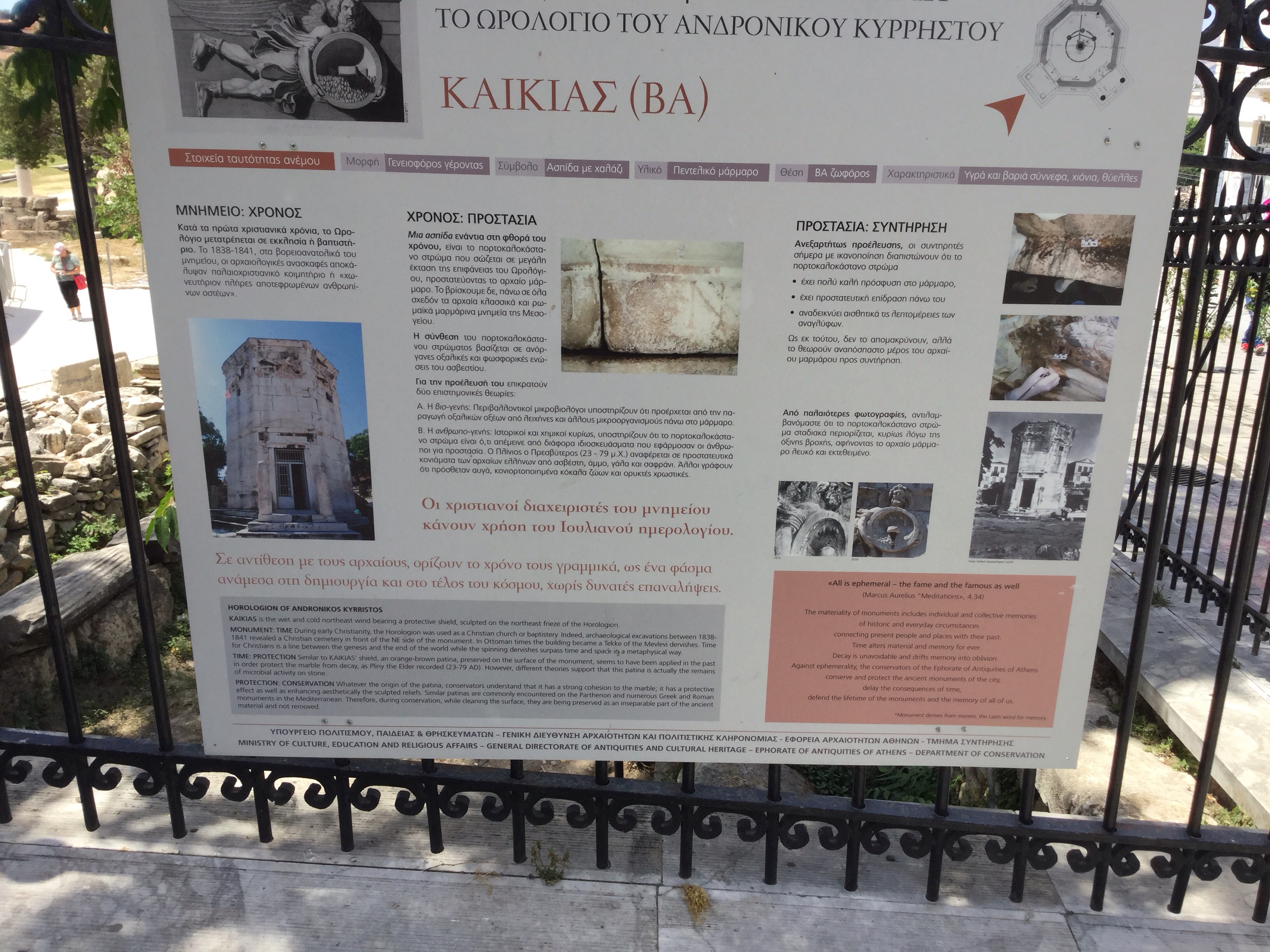May 26, 2016
Thursday, our last day in Athens before heading north to the Balkans. Jimmy, Heather, Shirley and I were on a mission to the Theater Dionysus on the other side of the Akropolis, winding our way up and down the steep and narrow streets in the hot afternoon sun.
Then, as always happens when you’re on your way to some place else, you run into something that you didn’t even know existed. First I noticed a long span of not just the usual construction site fencing, but that the gray wire was covered with signage. Behind the wire, along with all sorts of mechanical contraptions meant for tearing some things down and building up others, was this tall marble octagon tower–the Horologion of Andronikos, otherwise known as The Tower of the Winds. Built in the first century p.c.e. by the astronomer Andronikos (who hailed from Kyrrhos up north in Macedonia), the temple originally featured eight different different types of winds on each of its marble sides, each one represented by a male figure depicting that wind’s attributes. But things change. Throughout the centuries the tower took on many lives. Early in the Christian period it had been turned into a church and part of the ground around it into a cemetery. In the 15th century, it had been identified by one early traveler appropriately enough as the former temple of Aeolos, the Greek God of the winds; but, in later years, under the Ottoman Empire, it was used as a Dervish monastery. In any case, here in 2016 the rejuvenation of its initial incarnation as The Tower of the Winds had apparently become the focus of all this activity, of all this noise and dust. And, at least for as long as our own lifetime, any visitor to this spot will know its original name.
I’m not meaning to be snide here, but both wary and in awe, in the manner of the caretakers of this site and its renovation. Indeed displayed in the corner of an informational placard bolted to the fence, were these words from the Ephorate of Antiquities of Athens, an agency under the direction of the General Directorate of Antiquities, which in turn is under the aegis of the Ministry of Culture and Sports:
The materiality of monuments includes individual and collective memories
of histories and everyday circumstances
connecting present people and places with their past.
Decay is unavoidable and drifts memory into oblivion.
Against ephemerality the conservators of the Ephorate of Antiquities of Athens
conserve and protect the ancient monuments of the city,
delay the consequences of time,
defend the lifetime of the monuments and the memory of us all
*Monument derives from monere, the Latin word for memory.
This was not your usual bureaucratic boilerplate. This manifesto even had line-breaks–like a poem. Seeming to speak not just for those engaged in this one attempt to preserve and visually “perform” the past world, but for others engaged in such enterprises as well, this “poem”also seemed to realize that it too was part of a world continually disappearing, no matter how hard we might fight against the temporary—the ephemeral. Here, before my eyes, I caught a glimpse of how the ongoing knowledge of the world—its recognition, restoration and even reinterpretation—was going on not just in words but through the manipulation of the physical materials of the world. And, likewise, I was thankful that I was able to witness this visual and tactile shepherding of the past by my own body rather than through the printed word or the growing power of the Internet.
Dan
